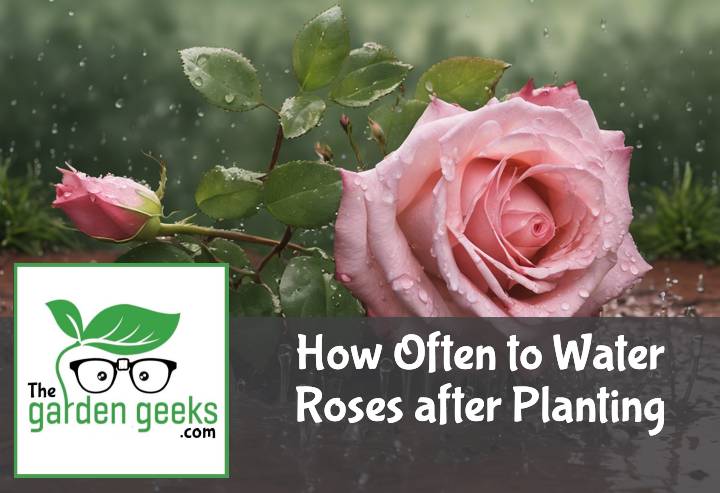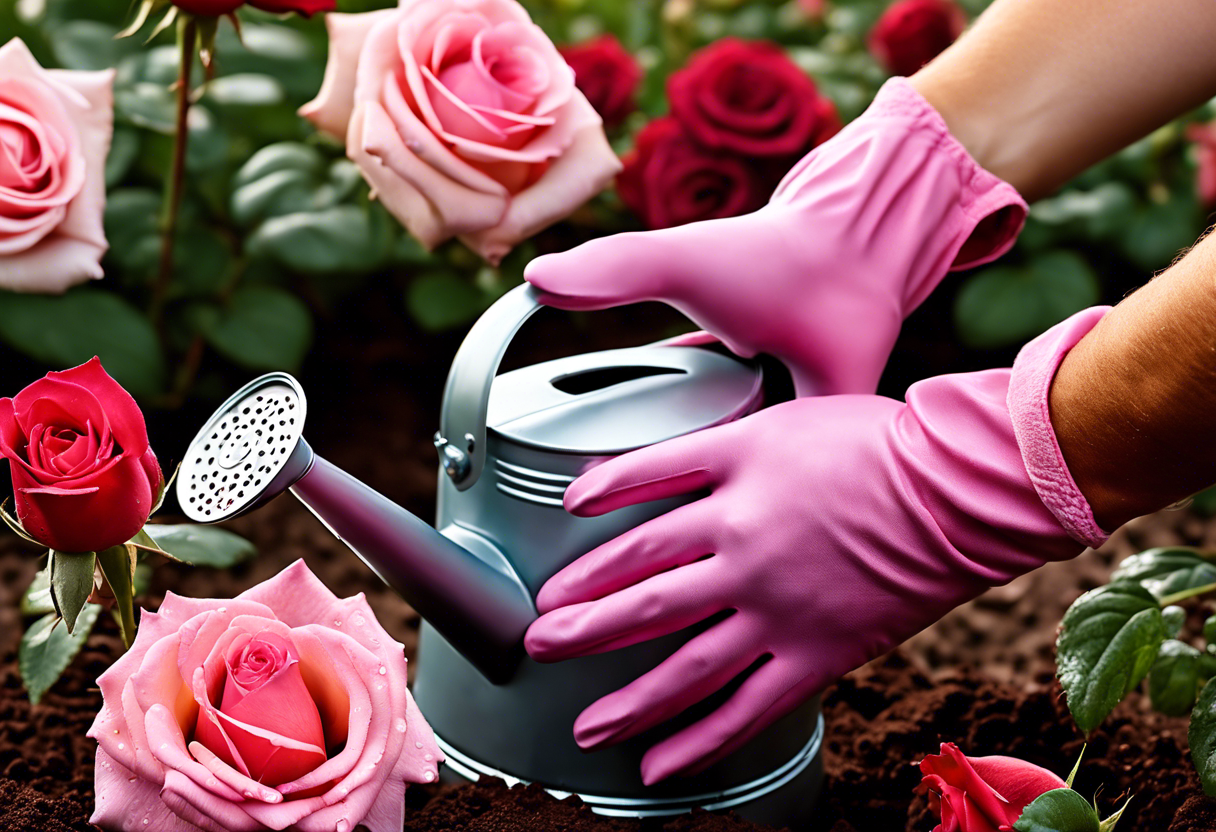Ever found yourself staring at your newly planted roses, hose in hand, wondering just how much water these beauties need? Trust me, I’ve been there. The question of How Often to Water Roses after Planting can be a bit of a head-scratcher for both newbie and veteran gardeners alike.
But don’t fret! We’re about to dive into the nitty-gritty of rose watering schedules. So pull up a chair, grab a cuppa, and let’s get our hands (metaphorically) dirty. Keep reading about How Often to Water Roses after Planting? (Definitive Guide).
Key Takeaways
- After planting roses, water them immediately to settle the soil.
- For the first few weeks, water daily or every other day.
- Once established (after 4-6 weeks), reduce watering to once a week.
- During hot and dry periods, increase frequency but avoid overwatering.
- Always water deeply to encourage root growth, early morning is the best time.
- Monitor soil moisture levels regularly; it should be moist but not soggy.
Understanding the Importance of Watering Roses
Watering roses is like the secret sauce to their growth and health. It’s a vital part of rose plant care that can’t be overlooked. Now, you might ask, how often to water roses after planting? Well, it’s not just about frequency but also about understanding the importance of watering roses correctly.
The Role of Water in Rose Plant Growth
Water plays a big role in rose plant growth. It’s like the lifeblood for these beauties. Without enough water, photosynthesis (that’s the process where plants make their food) can’t happen properly. So, if you’re scrimping on water, your roses might just go on a hunger strike!
But that’s not all! Water also helps in nutrient absorption. Think of it as a delivery guy who brings nutrients right to your rose plant’s doorstep (or rootstep, if you will). Without enough water, these nutrients can’t reach where they need to be and your roses might end up malnourished.
Risks of Overwatering and Underwatering Roses
Now let’s talk about overwatering and underwatering risks for roses. Both are like two sides of a bad coin for your rose plants.
Overwatering is like drowning your roses in love (and water!). Signs of overwatered roses include yellow leaves and wilting despite being wet. It’s kind of like giving someone too many chocolates – sure they’re sweet, but too much can make them sick!
On the flip side, underwatering is like forgetting your rose plant’s birthday – repeatedly! The effects of underwatered roses include dry soil and drooping leaves. It’s as if your roses are saying “Hey there! Remember us? We’re parched here!” So remember folks, balance is key when it comes to watering frequency for roses!
Factors Influencing How Often to Water Roses after Planting
When it comes to figuring out the rose watering frequency, there’s no one-size-fits-all answer. A few factors come into play, including the type of rose variety, soil conditions, and your local climate.
Type of Rose Variety
Different roses have different thirst levels. For instance, hybrid tea roses watering needs are quite high. They love a good drink! On the other hand, climbing roses aren’t as needy. Their climbing roses watering frequency is less compared to their hybrid tea cousins.
So, understanding your rose variety water requirements can save you from over or under-watering them. Remember, each rose is unique in its own way!
Soil Type and Drainage
The type of soil you’ve got plays a huge role in determining how often to water your roses. Sandy soil drains quickly, so if you’ve got this type of soil, your sandy soil rose watering routine might be more frequent.
On the flip side, clay soils retain water longer. So with clay soil rose care, you might need to hold back on the watering can a bit more often than not.
Ideal conditions? Well-drained loamy soil that holds moisture but doesn’t stay soggy. It’s all about balance when it comes to rose soil drainage!
Climate and Weather Conditions
Last but not least, let’s talk weather. If you’re living in a hot area where sunblock is your best friend, then chances are your roses will need more water too (watering roses in hot weather).
But what about winter? Well, even though they’re dormant during this time (winter rose care), they still need some moisture – just not as much.
And if you live somewhere where rain is a frequent guest? You might need to adjust your rainy climate rose watering routine accordingly. Remember, too much of a good thing can be bad!
Guidelines on Watering Newly Planted Roses
When it comes to caring for newly planted roses, watering is key. But how often should you do it? Well, that depends on a few factors. Different rose varieties have different water needs, and the climate and soil type can also influence the watering frequency for roses.
Ideal Frequency for Different Rose Varieties
Let’s start with hybrid tea roses. These divas of the rose world need a good drink every couple of days. On the other hand, climbing roses are more like camels – they can go longer without water.
Miniature roses? They’re somewhere in between. They like their soil moist but not soggy. Shrub roses and ground cover roses are pretty easy-going, too. They’re happy with a weekly watering in most climates.
But remember, these are just guidelines! Your rose garden maintenance plan should take into account your local weather and soil conditions.
Signs Your Roses Need More or Less Water
Now let’s talk about signs that your roses might be thirsty…or drowning! If your rose leaves start turning yellow or brown, or if they look wilted even after watering, those could be signs of overwatering.
On the flip side, if your rose leaves are curling up or looking crispy around the edges, that could mean they’re not getting enough water.
And don’t forget about growth patterns! If your rose isn’t blooming as much as it should be or if its growth seems stunted, it might be time to adjust your watering schedule.
Remember: understanding your rose plant water needs is crucial when figuring out how often to water roses after planting. So keep an eye out for these signs and adjust accordingly!
Techniques for Effective Watering of Roses
When it comes to rose plant care, getting your watering technique right is crucial. Now, you might be wondering, “How often to water roses after planting?” Well, the answer lies in mastering two key techniques: deep watering and mulching.
Deep Watering Method
Let’s dive into the deep end with deep watering roses. This method involves thoroughly soaking the soil, allowing water to reach deeper layers. It’s like giving your roses a good, long drink instead of just sipping on a cocktail straw!
The benefits? Oh, they’re plenty! Firstly, it promotes rose root growth by encouraging roots to dig deeper for moisture. Secondly, this method helps in maintaining soil moisture levels more effectively than shallow watering.
So next time you’re out with your watering can, remember – go deep or go home!
Mulching to Retain Moisture
Next up on our list of top-notch rose watering techniques is mulching. Think of it as a cozy blanket for your soil that keeps the moisture locked in.
By mulching roses, you’re essentially reducing water evaporation from the soil surface. This means less frequent watering and more time admiring your blooming beauties!
But wait – there’s more! Mulch also plays a vital role in supporting rose hydration by retaining soil moisture. So not only does it save you time and effort but also keeps your roses happily hydrated.
In conclusion, if you want to become a pro at effective rose irrigation, don’t forget to mulch!
Common Mistakes to Avoid When Watering New Roses
When it comes to how often to water roses after planting, there are a few common errors that can turn your rosy dreams into a thorny nightmare. The most frequent culprits? Overwatering and incorrect timing. These rose watering mistakes can seriously hamper your new rose plant care, so let’s dive in and learn how to avoid these rose planting errors.
Overwatering Newly Planted Roses
Overwatering is like the boogeyman of the rose world. It’s scary, it’s harmful, and it lurks where you least expect it. Too much H2O can lead to all sorts of nasty problems for your roses. The dangers of too much water for roses include root rot and fungal diseases – yikes!
Your new roses aren’t cacti, but they’re not fish either. They need just the right amount of water to thrive. So what’s the golden rule for preventing rose overwatering? Well, it depends on several factors such as weather conditions and soil type, but generally speaking, you should aim for moist (not soggy) soil.
Incorrect Timing of Watering
Now let’s talk about timing – another crucial factor in how often to water roses after planting. You see, watering your roses at the wrong time can be just as bad as over or underwatering them.
Watering during the heat of the day? Bad idea! Most of that precious moisture will evaporate before your roses get a chance to drink up. On the other hand, watering late in the evening or at night can leave your roses susceptible to fungal diseases (remember our chat about overwatering?).
The best time to water roses is early morning when temperatures are cooler and evaporation rates are lower. This gives your plants plenty of time to absorb that life-giving moisture before the sun gets too intense. So remember, timing is everything when it comes to your rose watering schedule!
To Wrap Up
In the grand dance of gardening, watering your roses is like the cha-cha – it’s all about rhythm and timing. We’ve learned that How Often to Water Roses after Planting isn’t a one-size-fits-all answer.
Remember, folks, roses aren’t cacti. They need their H2O fix just right – not too much, not too little. So keep those green thumbs ready and let’s create some bloomin’ marvelous gardens!





